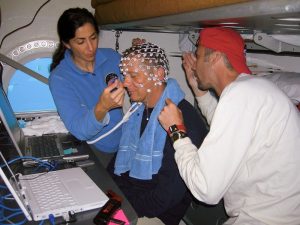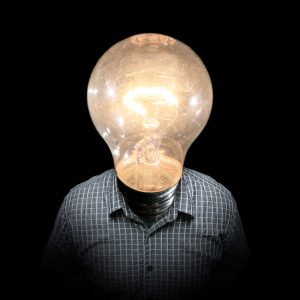11 The Unconscious
Unconscious psychological processes have fascinated people for a very long time. The idea that people must have an unconscious is based on the idea that (a) there is so much going on in our brains, and the capacity of consciousness is so small, that there must be much more than just consciousness; and that (b) unless you believe consciousness is causally disconnected from other bodily and mental processes, conscious experiences must be prepared by other processes in the brain of which we are not conscious. Not only logic dictates that action starts unconsciously, but research strongly suggests this too. Moreover, unconscious processes are very often highly important for human functioning, and many phenomena, such as attitude formation, goal pursuit, stereotyping, creativity, and decision making are impossible to fully understand without incorporating the role of unconscious processes.
Learning Objectives
- Understand the logic underlying the assumption that unconscious processes are important.
- Obtain a basic understanding of some important historical thoughts about unconscious processes.
- Learn about some of the important psychological experiments on the unconscious.
- Appreciate the distinction between consciousness and attention.
Have you ever grabbed a candy bar, chewing gum or a magazine as you purchased your groceries? These well-known “impulse buys” raise an intriguing question: what is really driving your decisions? While, on the one hand, you might argue that it is your conscious mind that decides what you buy, what you eat and what you read. On the other hand you’d probably have to admit that those celebrity magazines and salted chocolates weren’t actually on your shopping list with the eggs and the bread. So where did the desire to purchase them come from? As we will see in this module, there are a number of forces that operate on your thinking and decisions that you might not even be aware of; all of them being processed by the unconscious.
A Little Bit of History
Although the term “unconscious” was only introduced fairly recently (in the 18th century by the German philosopher Platner, the German term being “Unbewusstsein”), the relative “unconsciousness” of human nature has evoked both marvel and frustration for more than two millennia. Socrates (490–399 BC) argued that free will is limited, or at least so it seems, after he noticed that people often do things they really do not want to do. He called this akrasia, which can best be translated as “the lack of control over oneself.” A few centuries later, the Roman thinker Plotinus (AD 205–270) was presumably the first to allude to the possibility of unconscious psychological processes in writing: “The absence of a conscious perception is no proof of the absence of mental activity.”
These two ideas, first verbalized by Socrates and Plotinus respectively, were—and still are—hotly debated in psychology, philosophy, and neuroscience. That is, scientists still investigate the extent to which human behavior is (and/or seems) voluntary or involuntary, and scientists still investigate the relative importance of unconscious versus conscious psychological processes, or mental activity in general. And, perhaps not surprisingly, both issues are still controversial.

During the scientific revolution in Europe, our unconscious was taken away from us, so to speak, by the French philosopher Descartes (1596–1650). Descartes’s dualism entailed a strict distinction between body and mind. According to Descartes, the mind produces psychological processes and everything going on in our minds is by definition conscious. Some psychologists have called this idea, in which mental processes taking place outside conscious awareness were rendered impossible, the Cartesian catastrophe. It took well over two centuries for science to fully recover from the impoverishment dictated by Descartes.
This is not say that contemporaries of Descartes and later thinkers all agreed with Descartes’s dualism. In fact, many of them disagreed and kept on theorizing about unconscious psychological processes. For instance, the British philosopher John Norris (1657–1711) said: “We may have ideas of which we are not conscious. . . . There are infinitely more ideas impressed on our minds than we can possibly attend to or perceive.” Immanuel Kant (1724–1804) agreed: “The field of our sense-perceptions and sensations, of which we are not conscious . . .is immeasurable.” Norris and Kant used a logical argument that many proponents of the importance of unconscious psychological processes still like to point at today: There is so much going on in our brains, and the capacity of consciousness is so small, that there must be much more than just consciousness.
The most famous advocate of the importance of unconscious processes arrived at the scene in the late 19th century: the Austrian neurologist Sigmund Freud. Most people associate Freud with psychoanalysis, with his theory on id, ego, and superego, and with his ideas on repression, hidden desires, and dreams. Such associations are fully justified, but Freud also published lesser-known general theoretical work (e.g., Freud, 1915/1963). This theoretical work sounds, in contrast to his psychoanalytic work, very fresh and contemporary. For instance, Freud already argued that human behavior never starts with a conscious process (compare this to the Libet experiment discussed below).
Freud, and also Wilhelm Wundt, pointed at another logical argument for the necessity of unconscious psychological processes. Wundt put it like this: “Our mind is so fortunately equipped, that it brings us the most important bases for our thoughts without our having the least knowledge of this work of elaboration. Only the results of it become conscious. This unconscious mind is for us like an unknown being who creates and produces for us, and finally throws the ripe fruits in our lap.” In other words, we may become consciously aware of many different things—the taste of a glass of Burgundy, the beauty of the Taj Mahal, or the sharp pain in our toe after a collision with a bed—but these experiences do not hover in the air before they reach us. They are prepared, somehow and somewhere. Unless you believe consciousness is causally disconnected from other bodily and mental processes (for instance if one assumes it is guided by the gods), conscious experiences must be prepared by other processes in the brain of which we are not conscious.
The German psychologist Watt (1905), in an appealing experiment, showed that we are only consciously aware of the results of mental processes. His participants were repeatedly presented with nouns (e.g., “oak”) and had to respond with an associated word as quickly as they could. On some occasions participants were requested to name a superordinate word (“oak”-“tree”), while on other occasions they were asked to come up with a part (“oak”-“acorn”) or a subordinate (“oak”-“beam”) word. Hence, participants’ thinking was divided into four stages: the instructions (e.g., superordinate), the presentation of the noun (e.g., “oak”), the search for an appropriate association, and the verbalization of the reply (e.g., “tree”). Participants were asked to carefully introspect on all four stages to shed light on the role of consciousness during each stage. The third stage (searching for an association) is the stage during which the actual thinking takes place and hence this was considered the most interesting stage. However, unlike the other stages, this stage was, as psychologists call it, introspectively blank: Participants could not report anything. The thinking itself was unconscious, and participants were only conscious of the answer that surfaced.
Where Action Originates

The idea that we unconsciously prepare an action before we are conscious of this action was tested in one of psychology’s most famous experiments. Quite some time ago, Kornhuber and Deecke (1965) did experiments in which they asked their participants to perform a simple action, in this case flexing a finger. They also measured EEG to investigate when the brain starts to prepare the action. Their results showed that the first sign of unconscious preparation preceded an action by about 800 milliseconds. This is a serious amount of time, and it led Benjamin Libet to wonder whether conscious awareness of the decision to act appears just as long or even longer in advance as well. Libet (1985) replicated the Kornhuber and Deecke experiments while adding another measure: conscious awareness of the decision to act. He showed that conscious decisions follow unconscious preparation and only precede the actual execution of the action by about 200 milliseconds. In other words, the unconscious decides to act, we then become consciously aware of wanting to execute the action, and finally we act.
The experiment by Libet caused quite a stir, and some people tried to save the day for the decisive role of consciousness by criticizing the experiment. Some of this criticism made sense, such as the notion that the action sequence in the Libet experiments does not start with the EEG signals in the brain, but instead before that, with the instruction of the experimenter to flex a finger. And this instruction is consciously perceived. The dust surrounding the precise meaning of this experiment has still not completely settled, and recently Soon and colleagues (Soon, Brass, Heinze, & Haynes, 2008) reported an intriguing experiment in which they circumvented an important limitation of the Libet experiment. Participants had to repeatedly make a dichotomous choice (they were to press one of two buttons) and they could freely choose which one. The experimenters measured participants’ brain activity. After the participants made their simple choice many times, the experimenters could, by looking at the difference in brain activity for the two different choices in earlier trials, predict which button a participant was going to press next up to ten seconds in advance—indeed, long before a participant had consciously “decided” what button to press next.
The Unconscious in Social Psychological Processes
These days, most scientific research on unconscious processes is aimed at showing that people do not need consciousness for certain psychological processes or behaviors. One such example is attitude formation. The most basic process of attitude formation is through mere exposure (Zajonc, 1968). Merely perceiving a stimulus repeatedly, such as a brand on a billboard one passes every day or a song that is played on the radio frequently, renders it more positive. Interestingly, mere exposure does not require conscious awareness of the object of an attitude. In fact, mere-exposure effects occur even when novel stimuli are presented subliminally for extremely brief durations (e.g., Kunst-Wilson & Zajonc, 1980). Intriguingly, in such subliminal mere-exposure experiments, participants indicate a preference for, or a positive attitude towards, stimuli they do not consciously remember being exposed to.
The research on unconscious processes also greatly improved our understanding of prejudice. People automatically categorize other people according to their race, and Patricia Devine (1989) demonstrated that categorization unconsciously leads to the activation of associated cultural stereotypes. Importantly, Devine also showed that stereotype activation was not moderated by people’s level of explicit prejudice. The conclusion of this work was bleak: We unconsciously activate cultural stereotypes, and this is true for all of us, even for people who are not explicitly prejudiced, or, in other words, for people who do not want to stereotype.
Unconscious Processing and the Role of Attention

Insight into unconscious processes has also contributed to our ideas about creativity. Creativity is usually seen as the result of a three-stage process. It begins with attending to a problem consciously. You think and read about a problem and discuss matters with others. This stage allows the necessary information to be gathered and organized, but during this stage a truly creative idea is rarely produced. The second stage is unconscious; it is the incubation stage during which people think unconsciously. The problem is put aside for a while, and conscious attention is directed elsewhere. The process of unconscious thought sometimes leads to a “Eureka experience” whereby the creative product enters consciousness. This third stage is one where conscious attention again plays a role. The creative product needs to be verbalized and communicated. For example, a scientific discovery needs detailed proof before it can be communicated to others.
The idea that people think unconsciously has also been applied to decision making (Dijksterhuis & Nordgren, 2006). In a recent set of experiments (Bos, Dijksterhuis, & van Baaren, 2008), participants were presented with information about various alternatives (such as cars or roommates) differing in attractiveness. Subsequently, participants engaged in a distractor task before they made a decision. That is, they consciously thought about something else; in this case, they solved anagrams. However, one group was told, prior to the distractor task, that they would be later asked questions about the decision problem. A second group was instead told that they were done with the decision problem and would not be asked anything later on. In other words, the first group had the goal to further process the information, whereas the second group had no such goal. Results showed that the first group made better decisions than the latter. Although they did the exact same thing consciously—again, solving anagrams—the first group made better decisions than the second group because the first thought unconsciously. Recently, researchers reported neuroscientific evidence for such unconscious thought processes, indeed showing that recently encoded information is further processed unconsciously when people have the goal to do so (Creswell, Bursley, & Satpute, 2013).
People are sometimes surprised to learn that we can do so much, and so many sophisticated things, unconsciously. However, it is important to realize that there is no one-to-one relation between attention and consciousness (see e.g., Dijksterhuis & Aarts, 2010). Our behavior is largely guided by goals and motives, and these goals determine what we pay attention to—that is, how many resources our brain spends on something—but not necessarily what we become consciously aware of. We can be conscious of things that we hardly pay attention to (such as fleeting daydreams), and we can be paying a lot of attention to something we are temporarily unaware of (such as a problem we want to solve or a big decision we are facing). Part of the confusion arises because attention and consciousness are correlated. When one pays more attention to an incoming stimulus, the probability that one becomes consciously aware of it increases. However, attention and consciousness are distinct. And to understand why we can do so many things unconsciously, attention is the key. We need attention, but for quite a number of things, we do not need conscious awareness.
These days, most researchers agree that the most sensible approach to learn about unconscious and conscious processes is to consider (higher) cognitive operations as unconscious, and test what (if anything) consciousness adds (Dijksterhuis & Aarts 2010; van Gaal, Lamme, Fahrenfort, & Ridderinkhof, 2011; for an exception, see Newell & Shanks, 2014). However, researchers still widely disagree about the relative importance or contribution of conscious and unconscious processes. Some theorists maintain the causal role of consciousness is limited or virtually nonexistent; others still believe that consciousness plays a crucial role in almost all human behavior of any consequence.
Note: The historical overview of the way people thought about the unconscious is largely based on Koestler (1964).
Text Attribution
Media Attributions
- ASDA in Keighley
- jsc2006e13167
- Just Full of Ideas
Not conscious; the part of the mind that affects behavior though it is inaccessible to the conscious mind.
The idea that mental processes taking place outside conscious awareness are impossible.
(Electroencephalography) The recording of the brain’s electrical activity over a period of time by placing electrodes on the scalp.
The result of developing a more positive attitude towards a stimulus after repeated instances of mere exposure to it.
When a creative product enters consciousness.
A task that is designed to make a person think about something unrelated to an impending decision.

